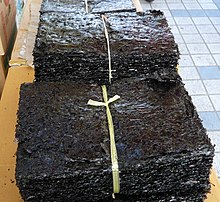Gimbap

Gimbap and some kimchi
|
|
| Korean alphabet : | 김밥 |
| Revised Romanization : | Gimbap |
| McCune-Reischauer : | Kimbap |
Gimbap (also Kimbap, Kim-Bab, Gim-Bab) is a popular Korean snack that is sometimes also eaten as lunch. It consists of dried purple kelp ( kor .: Gim) and rice (kor. Bab = cooked rice ), as well as, depending on the variation, other ingredients such as bulgogi , spinach , pickled radish ( kor .: Danmuji 단무지) and omelette . The Korean “gim” is very similar in color and taste to the Japanese “ Nori ”.
There are a large number of ingredients that can be added to the gimbap in a wide variety of combinations (such as sesame leaves, tuna, various types of cheese, fish eggs, crab meat). Then it is rolled and the rolls cut into bite-sized pieces. These are then eaten with chopsticks.
Comparison with Japanese dishes
In Western eyes, at first glance, gimbap resembles Japanese maki or sushi rolls. However, there are some differences between Japanese sushi rolls and Korean gimbap: Japanese sushi is often minimalist ( e.g. just a tuna roll or a pure salmon roll), while the gimbap contains several of the most diverse ingredients (meat and vegetables). In contrast to sushi, raw fish ( sashimi ) is usually not used in gimbap either. It is uncommon to eat gimbap with wasabi or soy sauce , but in German-Korean snacks gimbap is also served with wasabi and soy sauce.
There are two compelling theories of the origin of the gimbap. One is that gimbap originated from a Korean traditional dish, bokssam ( 복쌈 ). The other is that gimbap was derived from Japanese makizushi in the 20th century .
International gimbap cuisine
Gimbap is also available in many different shapes and variations, for example the California Roll, which was developed by Korean immigrants in the USA (mainly Los Angeles ) and is also offered as a sushi variation in many sushi restaurants. In addition, the gimbap is not only available in roll form, but also in the form of a triangle. To do this, however, the gim is roasted beforehand and brought into the triangular shape using a complicated folding technique.
Health aspects
Gimbab is characterized above all by the fact that you can change the filling depending on your own taste. In terms of health, gimbap is very valuable due to its moderate iodine content compared to other types of algae . It is therefore an extremely nutritious and healthy dish, especially in combination with the kimchi .
Individual evidence
- ↑ 정겨운 감동 주는 김밥 (통일 뉴스)
- ↑ HANTETSU CLUTUAL FOUNDATION (韓哲文 化 財 団 日本 生 ま れ の フ ァ ァ ー ス ト フ ー ド)
- ↑ NATE百科 事 典김밥 (キ ム パ プ) 」 ( Page no longer available , search in web archives ) Info: The link was automatically marked as defective. Please check the link according to the instructions and then remove this notice. 일본 음식 김초밥 에서 유래 되었다 (日本 食 の 海苔 巻 き が 由来)
- ↑ 東洋 経 済 日報 2009 年 5 月 1 日<随筆> ◇ キ ム パ プ (ノ リ 巻 き) 礼賛 論 ◇
- ↑ 2009 年 6 月 8 日 中央 日報ウ ナ ギ の 尻 尾 に こ だ わ る る ア ナ タ は 韓国 人
- ↑ 日 清 フ ー ズ 株式会社 フ ー ド ジ ャ ー ナ リ ス ト 平 松 洋子 「日本 か ら 韓国 韓国 へ 伝 わ っ た 食 べ 物」
- ↑ 日本 の 太 巻 き が 由来 で 、 近代 以降 に 韓国 で も 食 べ ら れ る よ う に な り ま し た. 2005 年 5 月 13 日 西 日本 新聞
- ↑ Stefanie Goldscheider: Nori, Wakame and Kombu The algae kitchen for gourmets. Retrieved October 4, 2010 .
